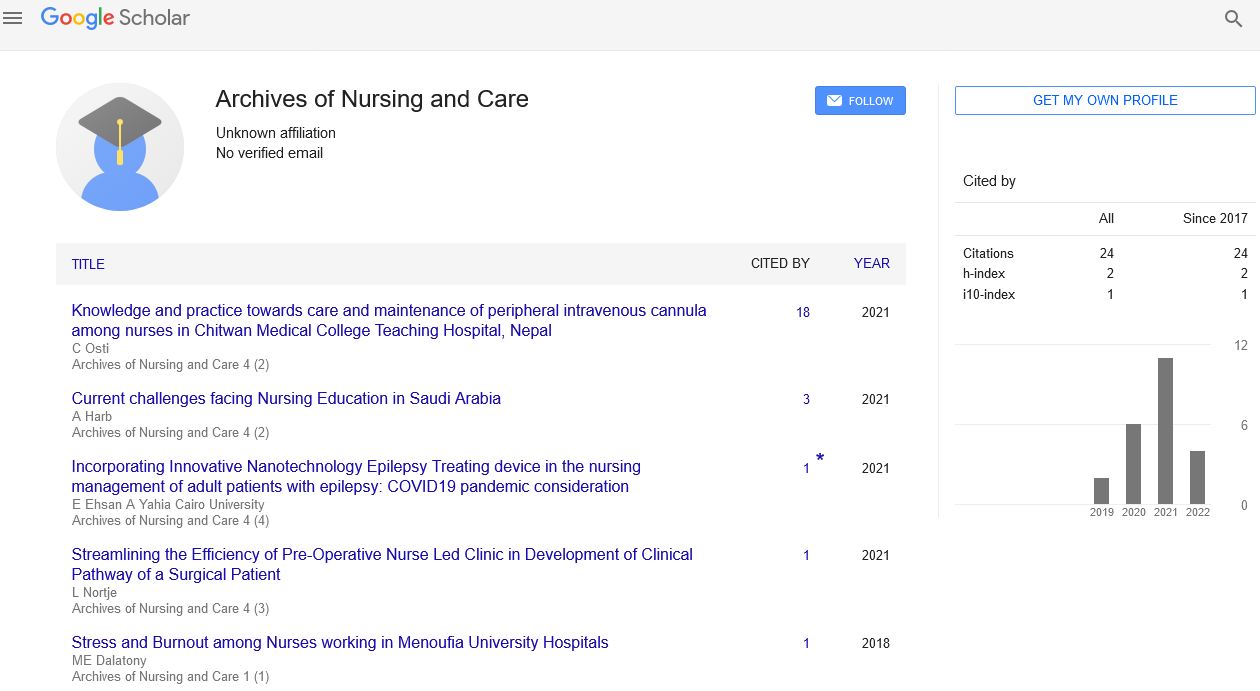Editorial - Archives of Nursing and Care (2023) Volume 6, Issue 3
Advanced Nursing: Primary Responsibilities of an Emergency Nurse for Pediatric Emergency
Elias Maria*
Pediatric Emergency Medicine, Alberta Children’s Hospital, Calgary, Canada
Pediatric Emergency Medicine, Alberta Children’s Hospital, Calgary, Canada
E-mail: Mariaelias@5286gmail.com
Received: 02-June-2023, Manuscript No. OANC-23-96758; Editor assigned: 05-June-2023, PreQC No. OANC-23- 96758 (PQ); Reviewed: 19-June-2023, QC No. OANC-23-96758; Revised: 26-June-2023, Manuscript No. OANC-22- 96758 (R); Published: 30-June-2023; DOI: 10.37532/oanc.2023.6(3).82-84
Abstract
Nursing diagnosis is a critical aspect of nursing practice, and the use of computers in diagnosing patients has become increasingly popular in recent years. There are many advantages to using computerized nursing diagnosis, including increased accuracy, efficiency, and standardization of diagnoses. In this review article, we will explore the benefits of using computerized nursing diagnosis and discuss some of the challenges and limitations of this approach. In order to help pathologists quickly locate the lesion area, improve the diagnostic efficiency, and reduce missed diagnosis, a convolutional neural network algorithm for the optimization of emergency nursing rescue efficiency of critical patients was proposed. Specifically, three convolution layers and convolution kernels of different sizes are used to extract the features of patients' posture behavior, and the classifier of patients' posture behavior recognition system is used to learn the feature information by capturing the nonlinear relationship between the features to achieve accurate classification. By testing the accuracy of patient posture behavior feature extraction, the recognition rate of a certain action, and the average recognition rate of all actions in the patient body behavior recognition system, it is proved that the convolution neural network algorithm can greatly improve the efficiency of emergency nursing. The current feature extraction speed and recognition effect of intelligent diagnosis of menopausal women’s health care behavior, this paper proposes to use a cross-layer convolutional neural network to extract behavior features autonomously and use support vector machine multiclass behavior classifier to classify behavior. Compared with the feature images extracted by traditional methods, the behavioral features extracted in this paper are related to the individual menopausal women and have better semantic information, and the feature description ability in the time domain and the space domain has been enhanced.
Keywords
Nursing diagnosis • Menopausal syndrome • Patient care
Introduction
Emergency nurses must also be skilled in the use of medical equipment and technology, such as electrocardiogram machines, ventilators, and defibrillators. They must be able to recognize and respond to changes in a patient's condition quickly and effectively. In addition to providing direct patient care, emergency nurses are also responsible for communicating with other members of the healthcare team [1], including physicians, pharmacists, and laboratory technicians. They must be able to accurately and effectively document patient care in medical records, and they must be able to communicate with patients and their families in a clear and empathetic manner.
The demand for emergency nurses is expected to continue to grow in the coming years, as the population ages and the need for emergency care increases. To meet this demand, many nursing schools are now offering specialized emergency nursing programs, and professional organizations, such as the Emergency Nurses Association, offer continuing education and certification programs for emergency nurses [2].
Inpatient overcapacity and the overutilization of emergency facilities as primary care centers are thought by some to be a driving force behind ED overcrowding. As a result, health care practitioners are working to improve patient care by adopting progressive strategies such as nurse-initiated protocols and Advanced Nursing Directives (ANDs). Like many other health care centres, the Pediatric Emergency Department (PED) at the Alberta Children’s Hospital (ACH) has seen significant growth in patient visits along with the corresponding increase in ED length of stay (LOS). Focusing on departmental flow, the development and implementation of Advanced Nursing Directives and their corresponding patient care maps have been successful in our PED [3]. Intentionally targeting 3 of the most common presentations to the PED, we developed processes in which children meeting unitbased nursing protocol criteria receive evidence-based, timely care from nursing staff prior to being assessed by an emergency physician. Extensive academic collaboration reviewing the existing clinical scoring systems and current research pertaining to these common pediatric medical complaints were referenced to construct hospital based care maps. The purpose of this paper is to review the theoretical constructs behind nursedriven protocols, the evidence supporting clinical scoring systems, and how the integration of the two form Advanced Nursing Directives (ANDs), which have the potential to significantly improve patient care outcomes, administrative metrics, and overall patient and caregiver satisfaction for children presenting to the ED [4].
Health-care-based clinical pathways, or care maps, are one method of practice standardization that have been shown to improve patient care outcomes. Pathways are evidence-based, structured algorithms that visually direct patient care provided by a team of health care professionals. As many pathways are developed by multidisciplinary practitioners involved in direct patient care, these guidelines can act as patient-focused and site-specific tools. Several care maps outline multispecialty, best-practice guidelines for a patient’s overall experience, relying on the collaboration of current research in specific care areas to create an effective overall pathway for patient care. These guidelines standardize care for a patient from their admission to the hospital through to their discharge home, reducing practitioner care variability [5], improving inter- and intradepartment communication, and ideally fostering high-quality patient outcomes. There are, of course, certain factors that may prevent a health care provider from following a clinical guideline. Once a health care professional determines that a patient meets the specific criteria to follow a clinical pathway, the care document should guide care and offer possible variations as a result of patient response to treatment. For example, if a nurse determines that a patient meets the criteria for a nurseinitiated protocol or Advanced Nursing Directive (AND) at the beginning of a clinical pathway and administers the suggested medications, the nurse should have the ability to assess that patient’s response and offer appropriate care [7].
In the ED and many other clinical settings, health care providers are often presented with scenarios of uncertainty, offering the challenge of questions related to diagnosis, severity of disease, and potential outcomes. Over the last 2 decades, tools aimed to assist the clinician in determining the probability or severity of a disease, have increased in number [8]. These Clinical Prediction Rules (CPRs) or Clinical Scoring Systems (CSS) offer evidence-based assistance. CPRs have been defined by Laupacis as decision-making tools that include 3 or more variables obtained from history, physical examination, or basic diagnostic testing that provide a probability of an outcome, or suggest a diagnostic or management course. Thus, 3 subtypes of CPRs are commonly discussed: those that are diagnostic, those that are prognostic, and those that are prescriptive. CPRs often come in different formats. There are those that require fulfillment of all criteria to direct management. Others allow clinicians to stratify the risk of a disease or severity of disease by using scoring ranges, while a final form offers a single cutoff score above which specific actions are suggested [9, 10]. For a CPR to be useful in the clinical setting, thorough testing is required. This includes strict criteria for deriving the rule, validating the rule, and finally assessing the impact of the rule once it has been implemented into practice.
Conclusion
Emergency nursing is a critical and challenging field of nursing that requires specialized skills and knowledge. Emergency nurses play a vital role in providing acute care to patients with urgent medical needs, and they are essential members of the healthcare team in emergency departments, urgent care centers, and critical care transport teams. The use of nurse-driven protocols is known to provide a stronger scientific foundation for clinical practice, to achieve consistency, efficiency, effectiveness, quality, and safety in medical care. Integrating previously validated, evidence based clinical prediction rules/scoring systems into nursing care in the pediatric emergency department through the introduction of Advanced Nursing Directives allows nurses to utilize their advanced assessment skills and apply previously validated research. The future implementation of Advanced Nursing Directives in ED practice and other clinical settings will empower nurses to have a greater impact on patient care and outcomes.
References
- El-Solh AA, Niederman MS, Drinka P. Nursing home acquired pneumonia: a review of risk factors and therapeutic approaches.Current Medical Research and Opinion. 26, 2707–2714(2010).
- Mills K, Nelson AC, Winslow BT et al.Treatment ofnursinghome-acquired pneumonia.American Family Physician. 79, 976–982(2009).
- Sarin J, Balasubramaniam R, Corcoran AM et al.Reducing the risk of aspiration pneumonia among elderly patients in long-term care facilities through oralhealthinterventions.Journal of the American Medical Directors Association.Current Medical Research and Opinion. 9, 128–135(2008).
- Marik PE, Kaplan D.Aspiration pneumonia and dysphagia in the elderly. 124, 328–336(2003).
- Mintz AH, Kestle J, Rathbone MPet al.A randomized trial to assess the efficacy ofsurgerytoradiotherapyin patients with a singlebrainmetastasis.Cancer.78, 1470–1476(1996).
- Yamamoto Y, Tsutsumi Y, Yoshioka Yet al.Site-specific PEGylation of a lysine-deficient TNF-alpha with full bioactivity.Nat Biotechnol.21, 546-552(2003).
- Kaneda Y, Kamada H, Yamamoto Yet al.The use of PVP as a polymeric carrier to improve the plasma half-life of drugs.Biomaterials.25, 3259-3266(2004).
- Tsunoda S, Kamada H, Yamamoto Yet al.Molecular design of polyvinylpyrrolidone-conjugated interleukin-6 for enhancement of in vivo thrombopoietic activity in mice.J Control Release.68, 335-341(2000).
- Norouzinia R, Aghabarari M, Kohan Met al.Health promotion behaviors and its correlation withanxietyand some students’demographic factors of Alborz University of Medical Sciences.Journal ofHealthPromotion Management. 2(4), 39- 49(2013).
- Pierce C.Health promoting behaviors of rural women with heart failure.Online Journal of RuralNursingandHealthCare. 5(2), 28-37(2005).
Indexed at,Google Scholar,Crossref
Indexed at,Google Scholar,Crossref
Indexed at,Google Scholar,Crossref
Indexed at,Google Scholar,Crossref
Indexed at,Google Scholar,Crossref
Indexed at,Google Scholar,Crossref
Indexed at,Google Scholar,Crossref

